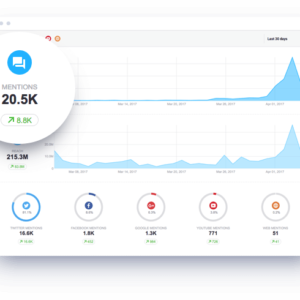In the digital age, with dozens of platforms and hundreds of promotional channels accessible to musicians, there are a million and one ways to grow your music career.
The challenge is in figuring out which mediums and channels to focus on, and how to best take advantage of them to grow music careers faster and reach new audiences.
In music, it’s all-too-common to take the safe route with career development and replicate what others do. But in an industry as fast-paced and competitive as the music business, safe doesn’t win the race.
Increasingly, what separates the pros from the amateurs, the go-getters from the left-behinders, is knowing how to use data analytics.
WHY MUSIC PROFESSIONALS SHOULD BECOME DATA-DRIVEN
With so much competition, yet so much opportunity, music professionals need to stay ahead of the curve: experiment with new ideas, adapt and evolve rapidly. The key to doing this successfully is having the right data when you test out a new approach, so you can figure out what does and doesn’t work.
Each platform, channel, and medium in the music industry produces mountains of data points every single day. Using this data and grounding your strategy in solid analytics allows you to measure the success of each action you take and continuously optimize your strategy.
3 WAYS MUSIC DATA CAN HELP PROFESSIONALS MAKE BETTER DECISIONS
Harnessing the power of data can have a transformative impact on music careers. Here are the 3 ways how data can help artists succeed:
1. Identifying local potential for artist growth
Music data provides critical insight into an artist's performance in local markets and highlights local opportunities (if you know how to track the data).
For example, let’s say you wake up to the news that your latest single has gone viral on YouTube in India. Then, the song gets picked up by local Indian radio, and the audience loves it. Suddenly, your song spreads across Indian airwaves, and in a couple of weeks, it’s in the top 50 on the local digital charts.
If you track all these data points from the get-go, you can capitalize on this trend early and transform a bit of short-lived local hype into a long-term fanbase.
While your average music professional scratches their head thinking, “hm, that’s weird,” the data-driven music professional is negotiating radio appearances and adding India to their tour schedule.
2. Assess the artist promotion strategy
Every artist and music career is unique, so there’s no one-size-fits-all approach to finding an audience. Some artists blow up on the radio, some go viral on YouTube, and others steadily grow their listenership through playlists on Pandora or Spotify.
In the music industry, you develop a promotion strategy through trial and error: by testing, experimenting, and seeing what works. Music data is the bedrock of this strategy: it allows you to assess the impact of promotional activities and benchmark the results both with previous campaigns and against other artist’s careers.
3. Using data to back up your pitch
Every music career is the result of an endless series of collaborations and partnerships between teams of interconnected professionals working in various areas of the industry (distribution, publishing, live performance, recording, and more).
Each partnership is an investment, of both time and resources. So, to make new partnerships, you need to convince other music professionals that you are a worthwhile investment. Sure, reputation can go a long way — but nothing convinces better than solid figures. Concrete data is the basis of every well-founded pitch.
BUT WHERE DO YOU GET THAT DATA?
Each music platform and channel generates a million data points, and the tricky part of music data analytics is tracking all the different sources across the music industry to get the full view of an artist’s career.
This complexity is compounded by the fact that not all music metadata is reliable. A solid-grounded analytical approach requires a complete and accurate data source that you can rely on.
HOW TO LEVERAGE MUSIC DATA FROM MULTIPLE SOURCES
Once you choose your music analytics tool stack, look for data in the following areas:
Social media performance on SoundCloud, Facebook, YouTube, Twitter, and Instagram
Digital charts across all major digital platforms, including Shazam, YouTube, and Spotify
Artist’s playlist exposure across Spotify, Apple Music and Deezer
Radio airplay across 1,600+ radio stations in 65 different countries
1710Media helps entertainment professionals make smarter and faster music business decisions by providing reliable data, beautiful visuals AND in-depth insights. We don't just show you numbers - we produce clean, precise and actionable insights, so you and your team can make the most efficient and informed decisions to nurture and grow your entire ecosystem.
At 1710 Media, we don't just display top-line trends and playlist data. We clean and refine your data before ingesting, allowing you to rest easy knowing what you are being shown is a true representation of your catalogue’s performance. Furthermore, you can share this data with anyone in your team, artist managers, PR, promoters and beyond.





